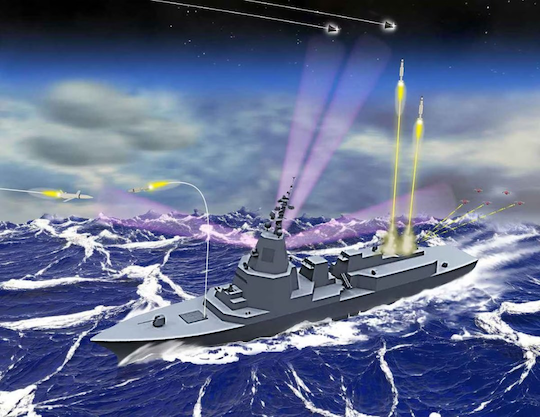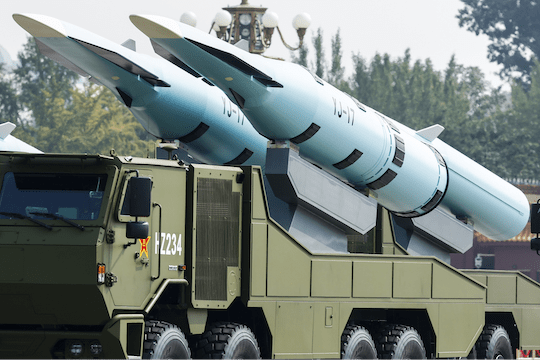Containing China is Becoming Untenable
For more than 80 years, American aircraft carrier strike groups have projected raw military power around the globe.
U.S. naval and air power were unrivaled. And with more than 850 military bases around the world, the American empire still has unparalleled reach.
Along with military might, the dollar remains a key pillar of the American Empire.
But let’s be frank. Both monetary and military power are in slow decline. America is no longer the world’s sole superpower.
Today, let’s address the dramatic changes we’ve seen in military technology over the past 2 decades.
Hypersonic Missiles: A New Achilles Heel
American aircraft carrier strike groups are protected by an advanced defense system called the Aegis Combat System. It includes radar, anti-air missiles, supercomputers, anti-torpedo measures, naval gunnery, and the automated Phalanx 20mm CIWS.
 Aegis system graphic, via Wikipedia
Aegis system graphic, via Wikipedia
Aegis is an incredibly advanced system. But over the past 30 years, rising global powers such as China and Russia have worked to circumvent such defense systems.
The primary method has been to develop hypersonic (maneuverable and faster than Mach 5) missiles. Today, China and Russia each have multiple hypersonics in production. These include ballistic, cruise, and anti-ship missiles.
Hypersonic missiles are extremely difficult for even the most advanced air defense systems to intercept.
A missile traveling at Mach 6 (6 times the speed of sound) is moving at around 4,600 miles per hour. A missile traveling at Mach 10, which China and Russia both produce, is rocketing at 7,600 MPH. That’s about 2 miles per second.
Even an advanced system like Aegis would struggle to intercept hypersonics. For example, London’s Financial Times recently highlighted the fact that American Patriot Missiles are struggling to intercept Russian Iskander and Kinzhal hypersonics in Ukraine:
The missiles now follow a typical trajectory before diverting and plunging into a steep terminal dive or executing manoeuvres that “confuse and avoid” Patriot interceptors.
It is a “game-changer for Russia”, said one former Ukrainian official.
Ukraine’s ballistic missile interception rate improved over the summer, reaching 37 per cent in August, but it plummeted to 6 per cent in September
We should note here that Aegis has more advanced interceptors than the older Patriot systems being used in Ukraine. So let’s guess that they might be able to intercept hypersonics at a 50% rate, as opposed to 6% recently in Ukraine. That’s still not good enough. A single hit is enough to cripple or sink even a mighty carrier.
Of course, this also assumes that China’s hypersonics are on par with Russia’s. We haven’t seen China’s hypersonics in action yet, but based on the performance of their air-to-air missiles in the Pakistan vs. India clash, their military has come a long way.
Naturally, the development of these speedy new missiles changes the global military balance. The fact that America is now playing catch-up in the race to develop hypersonics is an added complication.
In November of last year, before he became Defense Secretary, Pete Hegseth said the following on the Shawn Ryan Show podcast:
“So if our whole power projection platform is aircraft carriers and the ability to project power that way strategically around the globe. And, yeah, we have a nuclear triad and all that, but [carriers are] a big part of it. And if 15 hypersonic missiles can take out our 10 aircraft carriers in the first 20 minutes of a conflict, what does that look like?”
Hegseth added that in war games against China in the South China Sea, the U.S. military has a “perfect record. We lose every time”.
To be clear, I don’t foresee a war with China on the horizon. Both countries are armed with advanced nuclear weapons triads. So an outright war would be unwinnable.
The worst outcome I see would be a proxy war with Taiwan vs. China, but that would be a rather lopsided battle and I suspect the Taiwanese would rather surrender than fight it.
Clues from Taiwan
Taiwan is a tiny island off the coast of China with a population of 23 million. On paper, the United States recognizes that it is part of China. But in reality, the U.S. military is providing defense systems and assistance to Taiwan to fend off a potential Chinese invasion. It’s a tricky balancing act, to say the least.
Taiwan is critically important because it is home to TSMC (NYSE: TSM), which produces roughly 90% of the world’s advanced semiconductors. The chips in iPhones, NVIDIA GPUs, AMD processors, Android phones, and even Bitcoin miners are almost all produced in Taiwan at TSMC.
This is why President Trump, during his first term, began the process of bringing a TSMC manufacturing plant to Arizona. That plant is now beginning operations and should be churning out high-end chips in the very near future.
That’s a good thing. And now, the Trump administration has even bigger goals. They aim to bring 50% of TSMC manufacturing into America.
Commerce Secretary Howard Lutnick recently explained this goal in an interview with NewsNation. From CNBC:
“My objective, and this administration’s objective, is to get chip manufacturing significantly onshored — we need to make our own chips,” Lutnick said. “The idea that I pitched [Taiwan] was, let’s get to 50-50. We’re producing half, and you’re producing half.”
Apparently Taiwanese officials weren’t too happy about this goal. They want to keep their chip fabrication plants in their own country, naturally.
From the CNBC article:
Taiwan People’s Party Chairman Huang Kuo-chang reportedly called Lutnick’s proposal an attempt to “hollow out the foundations of Taiwan’s technology sector.”
Lutnick’s ambitious goal to on-shore 50% of TSMC chip production hints at an uncomfortable reality. It looks like China will, eventually, attempt to take Taiwan. If they do, their likelihood of success is high.
The question is will Trump be able to bring over a big chunk of TSMC production into the U.S. before China makes its move? I suspect that would be an acceptable compromise from China’s perspective. Whether Taiwan would agree is another matter.
We shall see. Stay tuned.



Comments: